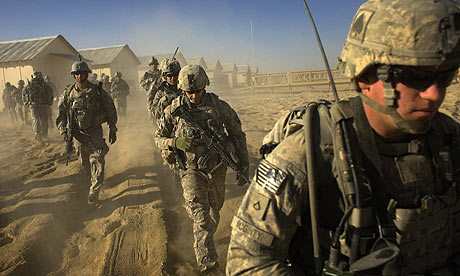Those include a fully entrenched Taliban enemy, reluctance of allies to commit enough trainers to instruct Afghan forces, rampant Afghan corruption and a lack of legitimacy of President Hamid Karzai's government.

US troops set out on a patrol in Paktika province, Afghanistan, close to the Pakistan border. Photograph: David Furst/AFP/Getty Images
Here are some questions and answers about U.S. strategy in Afghanistan and the main obstacles ahead, expected to be key discussion points for Karzai's visit to Washington this week.
IS THE TROOP 'SURGE' ON TRACK?
Yes. More than half of the 30,000 additional forces pledged by Obama in December have arrived in Afghanistan and the rest are expected to be in place by the end of August.
The extra U.S. troops are central to a campaign to gain full control of Kandahar, southern Afghanistan's largest city and the spiritual home of the Taliban movement.
The U.S. military hopes to deliver a victory in Kandahar when the Obama administration reviews progress in the war in December. Obama plans to start drawing down forces in July 2011.
HAVE THE EXTRA FORCES HURT THE TALIBAN?
That is not clear. The surge has put the Taliban under increased pressure, most notably with a February offensive to take the city of Marjah in southern Afghanistan. A top Defense Department official said the Taliban was losing momentum.
But even the Pentagon acknowledges the Taliban saw 2009 as its strongest year to date. A Pentagon report released last week said the Taliban's reach was still expanding in Afghanistan and it is increasingly able to launch sophisticated, deadly attacks.
No U.S. official is yet prepared to say momentum has shifted in the nearly nine-year-old war.
ARE ALLIES CONTRIBUTING MORE TROOPS?
Yes, but allies are not moving quickly enough for the U.S. timetable. This has been a particular worry given the need to quickly ramp up the size of Afghan forces to prepare for an eventual handover.
U.S. Defense Secretary Robert Gates, concerned about a lack of trainers from allies, recently decided to deploy an additional 850 U.S. trainers to Afghanistan. That is a temporary deployment due to end by September and should not take the "surge" above 30,000.
IS THE U.S. MEETING TRAINING GOALS?
The Afghan National Army counted 112,779 troops by the end of March, above the target for that month of 112,700. The Afghan National Police totaled 102,138, above a goal of 99,261.
Longer-term goals for the army are 134,000 by October 2010 and 171,600 by October 2011. Goals for the police are 109,000 by October 2010 and 134,000 by October 2011.
There are risks to those larger goals. The Afghan army lacks qualified officers, who require much more training than new recruits -- no small task in a nation with soaring illiteracy rates. There is greater concern over the police force, still considered to be largely untrained, corrupt and 15 percent of which test positive for drug use.
ANY PROGRESS ON CORRUPTION?
The U.S. military is deeply concerned about a perceived lack of legitimacy by the Afghan government.
Gains on the battlefield securing towns and cities for the Afghan state are not expected to be sustainable if the population opposes the Kabul-based government. This is a core principle of the counter-insurgency strategy backed by the Obama administration.
A Pentagon report released to Congress this month said the political will to tackle corruption "remains doubtful." The Pentagon also said the population only supported Karzai's government in 29 of the 121 Afghan districts considered most strategically important in the war.
ARE THERE FEWER CIVILIAN DEATHS?
The Pentagon believes accidental killings of civilians pose one of the greatest risks to U.S. strategy in Afghanistan and the top U.S. and NATO commander has sought to limit the number of casualties.
But high-profile incidents still happen regularly and the Pentagon has acknowledged that NATO forces killed 49 civilians between October and March. (Editing by Sue Pleming and Chris Wilson)

















No comments:
Post a Comment